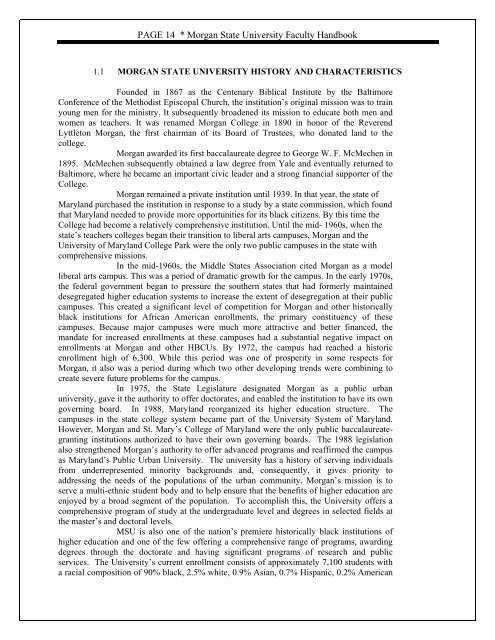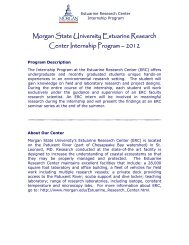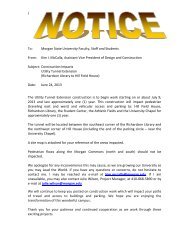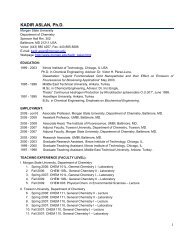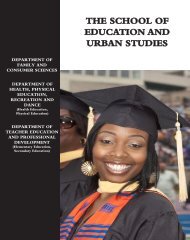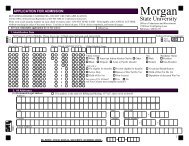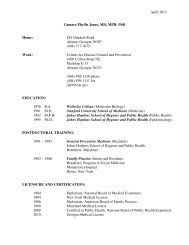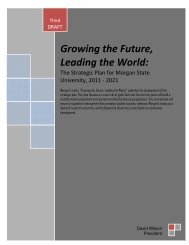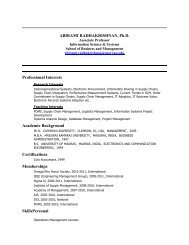FACULTY HANDBOOK July 2009 - Morgan State University
FACULTY HANDBOOK July 2009 - Morgan State University
FACULTY HANDBOOK July 2009 - Morgan State University
You also want an ePaper? Increase the reach of your titles
YUMPU automatically turns print PDFs into web optimized ePapers that Google loves.
PAGE 14 * <strong>Morgan</strong> <strong>State</strong> <strong>University</strong> Faculty Handbook1.1 MORGAN STATE UNIVERSITY HISTORY AND CHARACTERISTICSFounded in 1867 as the Centenary Biblical Institute by the BaltimoreConference of the Methodist Episcopal Church, the institution’s original mission was to trainyoung men for the ministry. It subsequently broadened its mission to educate both men andwomen as teachers. It was renamed <strong>Morgan</strong> College in 1890 in honor of the ReverendLyttleton <strong>Morgan</strong>, the first chairman of its Board of Trustees, who donated land to thecollege.<strong>Morgan</strong> awarded its first baccalaureate degree to George W. F. McMechen in1895. McMechen subsequently obtained a law degree from Yale and eventually returned toBaltimore, where he became an important civic leader and a strong financial supporter of theCollege.<strong>Morgan</strong> remained a private institution until 1939. In that year, the state ofMaryland purchased the institution in response to a study by a state commission, which foundthat Maryland needed to provide more opportunities for its black citizens. By this time theCollege had become a relatively comprehensive institution. Until the mid- 1960s, when thestate’s teachers colleges began their transition to liberal arts campuses, <strong>Morgan</strong> and the<strong>University</strong> of Maryland College Park were the only two public campuses in the state withcomprehensive missions.In the mid-1960s, the Middle <strong>State</strong>s Association cited <strong>Morgan</strong> as a modelliberal arts campus. This was a period of dramatic growth for the campus. In the early 1970s,the federal government began to pressure the southern states that had formerly maintaineddesegregated higher education systems to increase the extent of desegregation at their publiccampuses. This created a significant level of competition for <strong>Morgan</strong> and other historicallyblack institutions for African American enrollments, the primary constituency of thesecampuses. Because major campuses were much more attractive and better financed, themandate for increased enrollments at these campuses had a substantial negative impact onenrollments at <strong>Morgan</strong> and other HBCUs. By 1972, the campus had reached a historicenrollment high of 6,300. While this period was one of prosperity in some respects for<strong>Morgan</strong>, it also was a period during which two other developing trends were combining tocreate severe future problems for the campus.In 1975, the <strong>State</strong> Legislature designated <strong>Morgan</strong> as a public urbanuniversity, gave it the authority to offer doctorates, and enabled the institution to have its owngoverning board. In 1988, Maryland reorganized its higher education structure. Thecampuses in the state college system became part of the <strong>University</strong> System of Maryland.However, <strong>Morgan</strong> and St. Mary’s College of Maryland were the only public baccalaureategrantinginstitutions authorized to have their own governing boards. The 1988 legislationalso strengthened <strong>Morgan</strong>’s authority to offer advanced programs and reaffirmed the campusas Maryland’s Public Urban <strong>University</strong>. The university has a history of serving individualsfrom underrepresented minority backgrounds and, consequently, it gives priority toaddressing the needs of the populations of the urban community. <strong>Morgan</strong>’s mission is toserve a multi-ethnic student body and to help ensure that the benefits of higher education areenjoyed by a broad segment of the population. To accomplish this, the <strong>University</strong> offers acomprehensive program of study at the undergraduate level and degrees in selected fields atthe master’s and doctoral levels.MSU is also one of the nation’s premiere historically black institutions ofhigher education and one of the few offering a comprehensive range of programs, awardingdegrees through the doctorate and having significant programs of research and publicservices. The <strong>University</strong>’s current enrollment consists of approximately 7,100 students witha racial composition of 90% black, 2.5% white, 0.9% Asian, 0.7% Hispanic, 0.2% American


